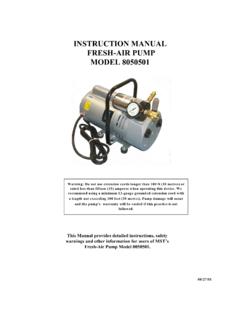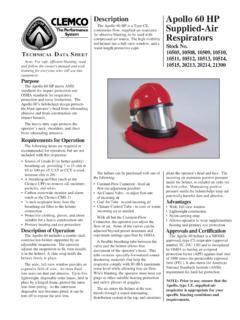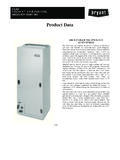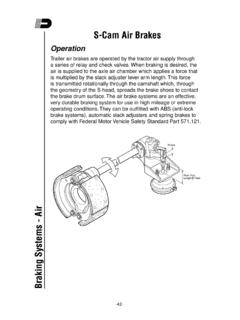Transcription of Breathing-Air Quality Testing Regulations, …
1 0 Breathing-Air Quality Testing regulations , standards and guidance Air Quality Testing Why? Page 2 International Breathing-Air standards Page 3 Frequency of Breathing-Air Tests Page 4 Recording Breathing-Air Quality test results Page 5 regulations , standards and Advisory Documents Compressed air for breathing apparatus from EN529 Page 6 COSHH L5(Sixth Edition 2013) Page 7 Respiratory Protective Equipment at Work, Page 9 a practical guide (HSG53) guidance on using Draeger tubes Evaluation of Draeger tubes Page 12 F2187 Draeger Deluxe Tube Tip Cutter Page 13 1 2 AIR Quality Testing WHY?
2 The required Quality of breathing air is stated in EN12021 is to provide information on the safe limits of potential contaminant gases within breathing air and to ensure that the life support gas of oxygen is of an adequate level. Compressed air for breathing normally originates from a compressor system installed or operating at the place of use and there are various factors that can affect the Quality and safety of this air. The air intake to the compressor can ingest airborne contamination from local processes and vehicle exhaust fumes which are not removed by standard breathing air filtration. Such air borne contamination may not be continuous but the pollution of the air supply may persist for hours or days.
3 Malfunctioning compressors, especially reciprocating type, can produce unsafe levels of both carbon monoxide and carbon dioxide. breathing air filtration has a finite life and can fail causing high levels of oil and water contamination to be present in the air. The performance of desiccant filters is dramatically affected by operating temperature. Infrequent validation may result in poor Quality air being supplied for an extended period Failure of the compressed air aftercooling will result in air entering the filtration at too high a temperature, this will cause the filtration to prematurely fail and pass excess levels of oil and water. Malfunctioning dryers can disturb the oxygen concentration to outside safe levels within the breathing air.
4 High levels of water in breathing air can freeze within RPD demand valves causing the air supply to fail. Insufficient air flow or pressure to the RPD will reduce the protection factor of the RPE and potentially expose the user to ingress of external contaminants. The effects of contaminants when breathed at elevated pressure can have a much greater effect on users than it would at normal pressure. Changes in the performance of compressor and filtration equipment are usually rapid in nature. Any failure affecting outlet air Quality may injure users for an extended period if Quality validation is infrequent. Odour alone is a poor indicator of air Quality , toxic as asphyxiant gasses are often odourless, the limits for oil pollution are lower than the threshold detection level that most people will notice.
5 All employers have a duty of care to their employees to ensure that the breathing air they are supplied with is adequate for the RPD they are using and safe to breathe. The points raised above may form the basis of the risk assessment called for in the European guidance document for the selection and use of respiratory protective devices EN 529. 3 International Breathing-Air standards Europe US Australia and New Zealand BS EN12021 & EN12021:2014 CGA Grade D AS-NZS 1715: 2009* Odour The gas shall be free from unsatisfactory odour or taste. None (No pronounced odour) No objectionable or nauseous odour Oxygen (21 1)% - - 22% Carbon Dioxide 500 PPM 1000 PPM 800 PPM Carbon Monoxide 5 PPM 10 PPM 10 PPM Oil mg/m3 5 mg/m3 1 mg/m3 Water Airline <40 Bar Where the apparatus is used and stored at a known temperature the pressure dewpoint shall be at least 5 C below likely lowest temperature.
6 Where the conditions of usage and storage of any compressed air supply is not known the pressure dewpoint shall not exceed -11 C. Dewpoint 50 F (67 PPM v/v), for SCBA use in extreme cold a dew point not to exceed -65 F (24 ppm v/v) or the dewpoint must be 10 F lower than the coldest temperature where the respirator is worn. Water High Pressure 40 to 200 bar 50 mg/m3 >200 bar 35 mg/m3 HP Charging Comp 25 mg/m3 Contain not more than 100 mg/m3 for cylinders initially filled to pressure of at least 120 bar. Note Also ensure that the test point volume and pressure is sufficient for the RPD being used. For AS-NZS 1715 the minimum requirement is 170 l/min continuous flow for each person, measured at the respirator.
7 Above is an extract only for full details refer to the individual standards . 4 Frequency of Breathing-Air Tests Low Pressure Systems The purpose of periodically Testing air Quality is to make sure that the control measures you have put in place are delivering the air Quality required. In the UK national forward to EN12021 advises that samples should be taken and analysed at least every three months or more frequently if there has been a change in, or concerns relating to, the production process. In the HSE guideline document Respiratory Equipment at Work (HSG53) it states you should base the frequency of such tests on a risk assessment, but again they should take place at least every three months, and more often when the Quality of air cannot be assured to these levels.
8 For mobile Breathing-Air compressors, in the UK, COSHH stipulates that, the employer should ensure that wherever a compressor is located, the Quality of air it supplies is not compromised by nearby contaminants. We strongly therefore recommend that for mobile compressors the air Quality is tested whenever it is first moved into a new position or prevailing wind conditions change. The final decision on frequency of test is the responsibility of the Employer and needs to not only reflect local legislation but also the task and frequency of use. It should be incorporated into their risk assessment and updated regularly to reflect results from ongoing Breathing-Air tests to maintain a robust control system.
9 High Pressure Systems Whilst up to a 3 month periodicity for Testing may be suitable for low pressure Breathing-Air systems, further consideration should be given to high pressure compressors where the life of filter elements are normally much shorter, typically 50 hours for a HP filter cartridge and this is reduced further in high ambient temperatures. Accordingly for these systems we recommend that your risk assessment for Testing HP systems should be based on the expected filter life and an air Quality test should first be completed when new filter elements are fitted and then again when they reach 50% of their life based on the hours run usage.
10 Subsequent tests would then be dependent on usage with a maximum interval between tests of 3 months. 5 Recording Breathing-Air Quality Test Results When undertaking Breathing-Air Quality tests, results should be retained. In the UK the regulations COSHH stipulates the information retained should include: the name and address of the employer responsible for the RPE; particulars of the equipment and of the distinguishing number or mark, together with a description sufficient to identify it, and the name of the maker; the date of examination and the name and signature or other acceptable means of identifying the person carrying out the examination and test; the condition of the equipment and details of any defect found, including for canister or filter respirators, the state of the canister and the condition of the filter.








